Ione, Washington
Ione /aɪˈoʊn/ is a town in Pend Oreille County, Washington, United States. The population was 447 at the 2010 census.[5]
Ione | |
|---|---|
| Ione, Washington | |
 Location of Ione, Washington | |
| Coordinates: 48°44′26″N 117°25′13″W | |
| Country | United States |
| State | Washington |
| County | Pend Oreille |
| Area | |
| • Total | 0.62 sq mi (1.60 km2) |
| • Land | 0.53 sq mi (1.38 km2) |
| • Water | 0.09 sq mi (0.22 km2) |
| Elevation | 2,090 ft (637 m) |
| Population | |
| • Total | 447 |
| • Estimate (2019)[3] | 472 |
| • Density | 888.89/sq mi (343.27/km2) |
| Time zone | UTC-8 (Pacific (PST)) |
| • Summer (DST) | UTC-7 (PDT) |
| ZIP code | 99139 |
| Area code(s) | 509 |
| FIPS code | 53-33560 |
| GNIS feature ID | 1521216[4] |
History
Ione was first settled in 1894.[6] Ione was officially incorporated on January 11, 1910.
Geography
Ione is located at 48°44′26″N 117°25′13″W (48.740540, -117.420313).[7]
According to the United States Census Bureau, the town has a total area of 0.58 square miles (1.50 km2), of which, 0.53 square miles (1.37 km2) is land and 0.05 square miles (0.13 km2) is water.[8]
Demographics
| Historical population | |||
|---|---|---|---|
| Census | Pop. | %± | |
| 1910 | 634 | — | |
| 1920 | 541 | −14.7% | |
| 1930 | 594 | 9.8% | |
| 1940 | 681 | 14.6% | |
| 1950 | 714 | 4.8% | |
| 1960 | 648 | −9.2% | |
| 1970 | 529 | −18.4% | |
| 1980 | 594 | 12.3% | |
| 1990 | 507 | −14.6% | |
| 2000 | 479 | −5.5% | |
| 2010 | 447 | −6.7% | |
| Est. 2019 | 472 | [3] | 5.6% |
| U.S. Decennial Census[9] | |||
2010 census
As of the census[2] of 2010, there were 447 people, 195 households, and 112 families residing in the town. The population density was 843.4 inhabitants per square mile (325.6/km2). There were 237 housing units at an average density of 447.2 per square mile (172.7/km2). The racial makeup of the town was 98.0% White, 0.4% Native American, 0.2% Asian, 0.2% from other races, and 1.1% from two or more races. Hispanic or Latino of any race were 4.3% of the population.
There were 195 households, of which 29.2% had children under the age of 18 living with them, 42.6% were married couples living together, 9.7% had a female householder with no husband present, 5.1% had a male householder with no wife present, and 42.6% were non-families. 34.9% of all households were made up of individuals, and 14.8% had someone living alone who was 65 years of age or older. The average household size was 2.29 and the average family size was 2.92.
The median age in the town was 43.5 years. 23.7% of residents were under the age of 18; 7.1% were between the ages of 18 and 24; 22.1% were from 25 to 44; 28.9% were from 45 to 64; and 18.3% were 65 years of age or older. The gender makeup of the town was 49.9% male and 50.1% female.
2000 census
As of the census of 2000, there were 479 people, 200 households, and 125 families residing in the town. The population density was 881.3 people per square mile (342.5/km2). There were 239 housing units at an average density of 439.7 per square mile (170.9/km2). The racial makeup of the town was 92.69% White, 0.21% African American, 2.09% Native American, 0.21% Asian, 0.21% from other races, and 4.59% from two or more races. Hispanic or Latino of any race were 1.46% of the population.
There were 200 households, out of which 30.5% had children under the age of 18 living with them, 48.5% were married couples living together, 7.5% had a female householder with no husband present, and 37.5% were non-families. 33.0% of all households were made up of individuals, and 17.0% had someone living alone who was 65 years of age or older. The average household size was 2.40 and the average family size was 3.08.
In the town, the population was spread out, with 28.6% under the age of 18, 5.8% from 18 to 24, 26.5% from 25 to 44, 23.2% from 45 to 64, and 15.9% who were 65 years of age or older. The median age was 38 years. For every 100 females, there were 90.8 males. For every 100 females age 18 and over, there were 90.0 males.
The median income for a household in the town was $24,083, and the median income for a family was $30,917. Males had a median income of $35,000 versus $17,500 for females. The per capita income for the town was $12,093. About 17.1% of families and 16.4% of the population were below the poverty line, including 15.1% of those under age 18 and 9.5% of those age 65 or over.
References
- "2019 U.S. Gazetteer Files". United States Census Bureau. Retrieved August 7, 2020.
- "U.S. Census website". United States Census Bureau. Retrieved 2012-12-19.
- "Population and Housing Unit Estimates". United States Census Bureau. May 24, 2020. Retrieved May 27, 2020.
- "US Board on Geographic Names". United States Geological Survey. 2007-10-25. Retrieved 2008-01-31.
- "2010 Census Redistricting Data (Public Law 94-171) Summary File". American FactFinder. United States Census Bureau. Retrieved 17 September 2012.
- Majors, Harry M. (1975). Exploring Washington. Van Winkle Publishing Co. p. 59. ISBN 978-0-918664-00-6.
- "US Gazetteer files: 2010, 2000, and 1990". United States Census Bureau. 2011-02-12. Retrieved 2011-04-23.
- "US Gazetteer files 2010". United States Census Bureau. Archived from the original on 2012-01-25. Retrieved 2012-12-19.
- United States Census Bureau. "Census of Population and Housing". Retrieved October 4, 2013.
External links
- https://web.archive.org/web/20110319013813/http://www.pendoreilleco.org/cities/i_details.asp Pend Oreille County Ione webpage
